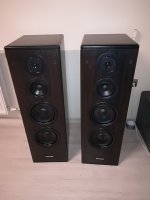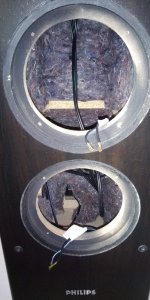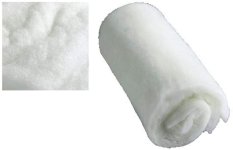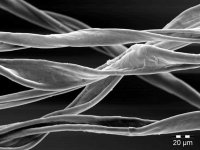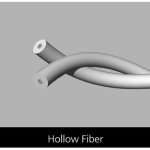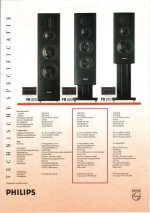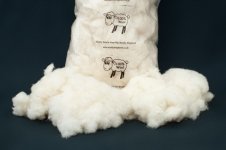Dear all,
I'm currently restoring my old Philips FB-820 speakers which I've owned since my teenage years and still very happy with.
Finally I've found the time to give my speakers some well deserved attention. I'm going to recap the crossover and after that I want to pay attention to cabinet interior damping material.
For now I've added three pictures of the crossover filters removed from my speakers. The capacitors actually are different in brand per filter, although even in capacity. A bit to my surprise.
Anyway, these are the values of the capacitors, some hard to readout:
2x 33uF, 35VAC, bipolar
1x 22uF, 35VAC / 100 VDC
1x 8u2 - 100V-35V AC, bipolar
1x 35V AC, L-A8
I want to not only recap but also improve with better, audiograde capacitors. All original capacitors are electrolytic.
Is there anyone that has advice for me what good replacement capacitors are? Like maybe Jantzen, Mundorf, MKP versions etc.
The FB-820 were standard consumer speakers at the time and as such I'm looking for a decent upgrade, not the top notch.
The speakers are rare and only a select group of people like the sound very much. I'm among one of them.
I'm new to the process of recap, hobby wise simply starting up and with that, unexperienced. So, I hope someone can help me to start up a bit
Any information and/or help much appreciated.
I've already learnt that removing the TCP can be helpful, soundwise.
Thank you,
Jenson.



I'm currently restoring my old Philips FB-820 speakers which I've owned since my teenage years and still very happy with.
Finally I've found the time to give my speakers some well deserved attention. I'm going to recap the crossover and after that I want to pay attention to cabinet interior damping material.
For now I've added three pictures of the crossover filters removed from my speakers. The capacitors actually are different in brand per filter, although even in capacity. A bit to my surprise.
Anyway, these are the values of the capacitors, some hard to readout:
2x 33uF, 35VAC, bipolar
1x 22uF, 35VAC / 100 VDC
1x 8u2 - 100V-35V AC, bipolar
1x 35V AC, L-A8
I want to not only recap but also improve with better, audiograde capacitors. All original capacitors are electrolytic.
Is there anyone that has advice for me what good replacement capacitors are? Like maybe Jantzen, Mundorf, MKP versions etc.
The FB-820 were standard consumer speakers at the time and as such I'm looking for a decent upgrade, not the top notch.
The speakers are rare and only a select group of people like the sound very much. I'm among one of them.
I'm new to the process of recap, hobby wise simply starting up and with that, unexperienced. So, I hope someone can help me to start up a bit
Any information and/or help much appreciated.
I've already learnt that removing the TCP can be helpful, soundwise.
Thank you,
Jenson.
As noted above, be careful about changing bipolars for completely different types -the resistance of those caps was likely accounted for by Philips as a functional part of the circuit. You can substitute MKPs / whatever, but if they have a lower ESR, then you'll probably need to add some resistance back into the circuit to ensure you haven't altered the transfer functions & general balance etc. As for the internal damping, the first question I'd ask (it's a serious one, not facetious) is what's wrong with the existing damping? Or to put it another way: what specific issue / issues does the existing damping have, which you hope to fix by changing it?
Careful about opening that can of worms. Without measurements to confirm the caps actually need to be replaced it's a total crapshoot.
Well, those values come always handy!
I'd just take the crossover out of the box -1st improvement
And rewire it point to point -2nd improvement
Then join the three different paths at amplifier's terminals - 3rd improvement
I'd just take the crossover out of the box -1st improvement
And rewire it point to point -2nd improvement
Then join the three different paths at amplifier's terminals - 3rd improvement
Thanks for warning and yes, I will carefully select new capacitors. There's actually a good Dutch forum (I'm also Dutch) about my speakers where lots of members already replaced the caps with new ones (with beautiful results). Just wanted some additional input on this forum as well.As noted above, be careful about changing bipolars for completely different types -the resistance of those caps was likely accounted for by Philips as a functional part of the circuit. You can substitute MKPs / whatever, but if they have a lower ESR, then you'll probably need to add some resistance back into the circuit to ensure you haven't altered the transfer functions & general balance etc. As for the internal damping, the first question I'd ask (it's a serious one, not facetious) is what's wrong with the existing damping? Or to put it another way: what specific issue / issues does the existing damping have, which you hope to fix by changing it?
There's no problem with the original damping (how can there be), however, the original use of damping material in my speakers is very limited; with some rear parts of the cabinet not covered and really a big part of the cabinet entirely free. So I want to experiment with rockwool. fill it up a bit more, to make the lower end of the frequencies 'more stable'. It will be a trail and error case. I've had these speakers for over 30 years now so I know them pretty well.
In the past they got new conus rings (whats the name in english?) made by rubber in stead of soft foam. It turned out magically well with the drivers giving a much more solid bass, also staying much more solid on high volumes. It was partly a choise and partly a bit of luck with the good outcome.
I did read something about ESR values already and will keep it in mind. I'll probably stick to the others who already made a proper recap, that way I can't really go all that wrong. A hobby for me, not too sophisticated. Thank you.
As noted above, be careful about changing bipolars for completely different types -the resistance of those caps was likely accounted for by Philips as a functional part of the circuit.
if you would guess, how much resistance would old elyt caps have when new compared to what they have today? 0,2 ohm have become 2 ohms?
if you would guess, how much resistance would old elyt caps have when new compared to what they have today? 0,2 ohm have become 2 ohms?
I honestly would not know so I do not dare to guess 🙂. In the past I only read about it generally, like capacitors degrading over time. And with my speakers being over 30 years old now I like the idea of replacing them with brand new capacitors. With all opinions around I try to make a decent choice and one that suits me fine. But I'll check this subject on the Dutch, dedicated to my speakers forum. Thanks.if you would guess, how much resistance would old elyt caps have when new compared to what they have today? 0,2 ohm have become 2 ohms?
I probably wouldn't guess on something like that. 😉 One of those 'how long is a piece of string' situations unfortunately; depends on the cap, its original value & use it's been subjected to. I've seen some that were still close to what they would have been when they left the factory. Others -pick a number, small or large.
In the past they got new conus rings (whats the name in english?)
Hi Jenson! 'Cone surrounds' is the term to which you refer.
I suggest Mundorf ECap PLAIN bipolar electrolytic capacitors as replacements in order to retain, as far as possible, the voicing of the speakers as intended by the manufacturer. https://cdn.shopify.com/s/files/1/0809/2387/files/Ecap_plain.pdf?9887667108540766049
Consider also that a 33 uF MKP film capacitor can measure 6 cm in length x 3 cm in diameter compared to an Ecap's 4 cm x 2.5 cm, which may prove problematical on a cramped circuit board.
Galu, I've been looking around at the many options (among them is Mundorf) and ended up with the following replacement capacitors:
2x JANTZEN AUDIO ELECAP Electrolytic Capacitor 100V 22µF 5%
2x JANTZEN AUDIO ELECAP Electrolytic Capacitor 100V 3.3µF 5%
4x JANTZEN AUDIO ELECAP Electrolytic Capacitor 100V 33µF 5%
2x JANTZEN AUDIO ELECAP Electrolytic Capacitor 100V 8.2µF 5%
Looking at the speakers, pretty standard models back in the 90' I guess MKP capacitors is a bit 'out of balance'; looking at their prices also. And as you mention, their size is problematic.
I love the Philips FB-820 speakers. The cabinet is in fact pretty sturdy built, with a 3,5cm thick MDF front baffle and with 2 additional board units halfway inside the cabinet to make it more sturdy. After replacing the cone surrounds with new, rubber versions, the bass became so much better, more 'solid' and 'firm'.
I would describe the FB-820 as sounding 'neutral', with a warmish sound. Have them for over 30 years now.
2x JANTZEN AUDIO ELECAP Electrolytic Capacitor 100V 22µF 5%
2x JANTZEN AUDIO ELECAP Electrolytic Capacitor 100V 3.3µF 5%
4x JANTZEN AUDIO ELECAP Electrolytic Capacitor 100V 33µF 5%
2x JANTZEN AUDIO ELECAP Electrolytic Capacitor 100V 8.2µF 5%
Looking at the speakers, pretty standard models back in the 90' I guess MKP capacitors is a bit 'out of balance'; looking at their prices also. And as you mention, their size is problematic.
I love the Philips FB-820 speakers. The cabinet is in fact pretty sturdy built, with a 3,5cm thick MDF front baffle and with 2 additional board units halfway inside the cabinet to make it more sturdy. After replacing the cone surrounds with new, rubber versions, the bass became so much better, more 'solid' and 'firm'.
I would describe the FB-820 as sounding 'neutral', with a warmish sound. Have them for over 30 years now.
You can't go wrong with those replacements, Jenson, and your Philips speakers should be good for another 30 years.
Happy continued listening!
Happy continued listening!
Thanks Galu. Just made the order. Once I've replaced the capacitors and bridget the TCP, I will take on the damping material inside the cabinets.
For sure it feels good to have 'fresh'/better capacitors from now on. Also to have exactly the same ones on each crossover filter (which was weird to notice).
Here's a picture of the speakers, the Philips FB-820 (dated 1990 with a stamp inside the cabinet):
For sure it feels good to have 'fresh'/better capacitors from now on. Also to have exactly the same ones on each crossover filter (which was weird to notice).
Here's a picture of the speakers, the Philips FB-820 (dated 1990 with a stamp inside the cabinet):
Attachments
Last edited:
Thank you!
As different damping materials perform different functions, I thought you might like to do some preparatory reading:
https://www.qtasystems.co.uk/articles/how-to-damping.htm
As different damping materials perform different functions, I thought you might like to do some preparatory reading:
https://www.qtasystems.co.uk/articles/how-to-damping.htm
I read that article a while ago. Found it online searching for the subject of speaker damping. Thanks anyway of course for sharing.
On this forum I also found this topic a while back. Also interesting regarding choices with damping materials:
https://www.diyaudio.com/community/threads/full-range-tc9-line-array-cnc-cabinet.303417/post-5049513
The subject starts at about #184
Recently I changed the damping material of a set Sony SS-86E speakers, from BAF only to Rockwool only. I was surprised at how I could hear the difference...in a positive way. Especially the bass was ' lower', as if the speakers got ' bigger'. It made a difference. Maybe not huge I will say, but, pretty noticeable at least to me.
The small cabinets were pretty well stuffed with BAF at first (from factory). Would describe it as 90% filled, no pressure applied to the BAF. I used more or less the same amount of rockwool, no pressure used and it does not touch the woofer magnet at the back, so, I left a little bit of space. Anyway, I'm happy with the effect and kept it this way.
Now looking forward to recapping my FB-820 crossovers and after that, the damping follows.
On this forum I also found this topic a while back. Also interesting regarding choices with damping materials:
https://www.diyaudio.com/community/threads/full-range-tc9-line-array-cnc-cabinet.303417/post-5049513
The subject starts at about #184
Recently I changed the damping material of a set Sony SS-86E speakers, from BAF only to Rockwool only. I was surprised at how I could hear the difference...in a positive way. Especially the bass was ' lower', as if the speakers got ' bigger'. It made a difference. Maybe not huge I will say, but, pretty noticeable at least to me.
The small cabinets were pretty well stuffed with BAF at first (from factory). Would describe it as 90% filled, no pressure applied to the BAF. I used more or less the same amount of rockwool, no pressure used and it does not touch the woofer magnet at the back, so, I left a little bit of space. Anyway, I'm happy with the effect and kept it this way.
Now looking forward to recapping my FB-820 crossovers and after that, the damping follows.
Here's a picture of the FB-820 cabinet interior. From factory this typical kind of cheap, soft material (often used for protecting heavy stuff during transport...don't know the name for it) is used for damping; and not a lot of it. In time I will experiment with adding rockwool.
Attachments
Your Philips speakers certainly look the business! I presume the enclosures are sealed?
The damping material in your photo above is a commonly used mix of recycled wool/cotton/denim/synthetic fibres.
Do consider 100% wool and/or cotton as a filling. The random orientation of natural fibres results in sound absorption properties that are superior to synthetic fibres (see microphotographs in attachments).
https://www.woollyshepherd.co.uk/loudspeaker-wool/
The damping material in your photo above is a commonly used mix of recycled wool/cotton/denim/synthetic fibres.
Do consider 100% wool and/or cotton as a filling. The random orientation of natural fibres results in sound absorption properties that are superior to synthetic fibres (see microphotographs in attachments).
https://www.woollyshepherd.co.uk/loudspeaker-wool/
Attachments
Read about wool too...and like you mention, because of its randomness, it seems a good (if not the best) option. Thanks again for the link. Always helpful in getting directions.
Rockwool for me is a cheaper alternative with still good results I think. I'll dive into the different materials some more when the time comes and then decide what I will do. Of course, my speakers are not high-end (though still very nice quality) but the idea of having best possible damping and a solid crossover inside, is tempting.
Oh, and by the way, yes, they are closed cabinets, so no bass reflex port.
I have a set of pretty unique spikes available as well, ready to take back into use once I've finished this project. My late grandfather made them (he was still an old fashioned smith) specially for my when I bought these speakers more then 30 years back now. Huge nostalgic value for me too. Maybe fun to post a picture here; maybe of the rockwool I use too.
Will be continued.
Rockwool for me is a cheaper alternative with still good results I think. I'll dive into the different materials some more when the time comes and then decide what I will do. Of course, my speakers are not high-end (though still very nice quality) but the idea of having best possible damping and a solid crossover inside, is tempting.
Oh, and by the way, yes, they are closed cabinets, so no bass reflex port.
I have a set of pretty unique spikes available as well, ready to take back into use once I've finished this project. My late grandfather made them (he was still an old fashioned smith) specially for my when I bought these speakers more then 30 years back now. Huge nostalgic value for me too. Maybe fun to post a picture here; maybe of the rockwool I use too.
Will be continued.
Rockwool is effective, one of the best. By the way, no need to compress it the way they compress BAF.In time I will experiment with adding rockwool.
- Home
- Loudspeakers
- Multi-Way
- Specs new capacitors for crossover filter
